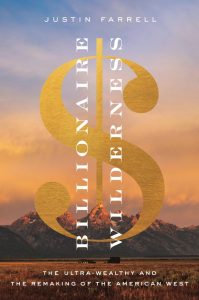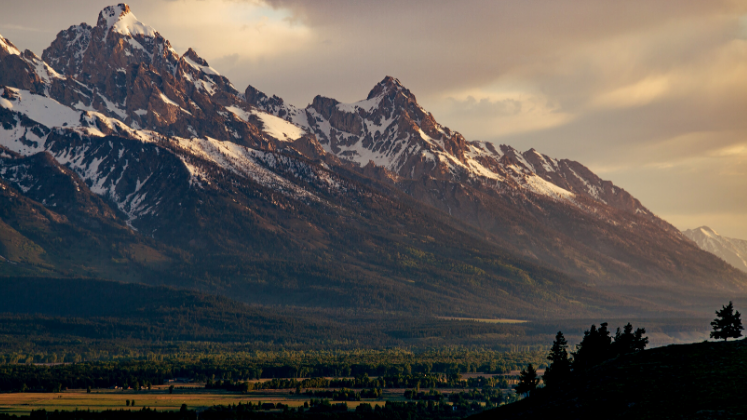In Billionaire Wilderness: The Ultra-Wealthy and the Remaking of the American West, Justin Farrell examines the lives of the ultra-wealthy who make Teton County, Wyoming, the richest county in the United States, focusing on their views towards each other, the environment and the county’s working-class community. While this ambitious study raises more questions than it provides definite answers about the ultra-wealthy in the western United States, the book undertakes the necessary groundwork to open up further examinations of this steadily growing social class, writes Evan Bonney.
Billionaire Wilderness: The Ultra-Wealthy and the Remaking of the American West. Justin Farrell. Princeton University Press. 2020.
 With Billionaire Wilderness, Yale sociologist Justin Farrell promises a unique study of the lives of the ultra-wealthy who make Teton County, Wyoming, the richest county in the United States. This isolated area, tucked in the Teton Mountain range of the Rocky Mountains, may not be the first place that comes to mind when one thinks of the world’s most affluent, but as one millionaire resident admits, the county seat of Jackson Hole is currently ‘where the billionaires chase the millionaires out of town’ (218). It is to these individuals with a net worth of $30 million or more that Farrell turns. Yet, instead of merely highlighting the socio-economic incentives that attract the ultra-wealthy to Wyoming, Farrell focuses on examining their views towards each other, the environment and Teton’s local working-class community.
With Billionaire Wilderness, Yale sociologist Justin Farrell promises a unique study of the lives of the ultra-wealthy who make Teton County, Wyoming, the richest county in the United States. This isolated area, tucked in the Teton Mountain range of the Rocky Mountains, may not be the first place that comes to mind when one thinks of the world’s most affluent, but as one millionaire resident admits, the county seat of Jackson Hole is currently ‘where the billionaires chase the millionaires out of town’ (218). It is to these individuals with a net worth of $30 million or more that Farrell turns. Yet, instead of merely highlighting the socio-economic incentives that attract the ultra-wealthy to Wyoming, Farrell focuses on examining their views towards each other, the environment and Teton’s local working-class community.
From the start, Farrell stresses that Billionaire Wilderness seeks to challenge stereotypes of the affluent in the United States that ‘mask complexity and discourage the empathy and objectivity researchers need to understand any social group from the inside’ (5). Consequently, he takes a predominantly qualitative approach, using hundreds of personal interviews either with the ultra-wealthy themselves, Teton County community activists or with the Latino workers who total 30 per cent of Teton’s local population. These sources differentiate Billionaire Wilderness from similar studies, such as Peter Dauvergne’s Environmentalism of the Rich, which focuses exclusively on the socio-political uses of conservationist philanthropy by major corporations. But despite its unique sources, Billionaire Wilderness often feels too ambitious for one comprehensive study of the ‘ultra-wealthy and the remaking of the American West’.
This is most evident in the book’s structure. Farrell opens his study with five chapters that detail the social mechanics of the ultra-wealthy in Teton County, revealing what fiscally attracts them to Wyoming, how they view environmental conservation and what types of local philanthropies they endorse. These chapters are Farrell’s strongest as they explain the socio-economic motivations that attract the ultra-wealthy to this particular part of the Rocky Mountains, with one ultra-wealthy individual admitting that Wyoming is ‘the best onshore version of an offshore trust’ (126).

From Chapters Six to Eight, however, Farrell principally adopts a social-psychological approach. Here, he aims to understand why the ultra-wealthy idealise what he terms the ‘Western authenticity’ of the landscape and of Teton’s working-class community (183). Although this section seems dislocated from the first, Farrell attempts to combine his two approaches in his two concluding chapters, focusing exclusively on the opinions of the workers who are often either directly or indirectly employed by ultra-wealthy residents. Their views vary widely, with several saying that they ‘don’t think the rich can affect the community in a negative way’ (263), while others express that the ultra-wealthy ‘take care of the wolves more than the Latino workers in this community’ (271). For Farrell, highlighting this contrast alongside the testimonies of the ultra-wealthy is crucial for finding solutions that ‘build trust’ and ‘instil greater empathy’ between all social classes of Teton County (307-308).
These intentions are noble, but Farrell’s attempt to interlace two distinct analytical frameworks inadvertently undermines the tenor of his conclusions. An illustrative example is in Chapter Eight, which examines if ‘[the ultra-wealthy] feel guilty’ for the widening income gap that makes Teton County the most unequal in the United States (4; 237). After examining multiple interviews with ultra-wealthy residents, Farrell ultimately concludes that, despite a few outliers, the ultra-wealthy absolve themselves from guilt by either citing the disputed theory of trickle-down economics as proof that they invigorate the local economy, or by blaming socio-economic divisions on newcomers to the Teton circle of ultra-wealthy residents. This is a solid insight, but it is unclear how this conclusion challenges the reader to pause before jumping to what Farrell describes as ‘our hasty desire to brand [the ultra-wealthy] individually as either saviors or monsters, good or evil, deserving or undeserving, environmental heroes or destroyers of nature’ (300). For readers expecting a study that encourages them to think beyond these binaries, Billionaire Wilderness may prove frustrating.
Farrell could have enriched his analysis by demonstrating how the ultra-wealthy of Teton County are representative of a particular subgroup of the ultra-wealthy in the United States that adopts a distinct set of beliefs and behaviours. Indeed, it is surprising that Farrell opts to consider the ultra-wealthy as a uniform social cohort, given that what emerges from several of his sources is that there are clear divisions among the ultra-wealthy themselves. This is most apparent with the ultra-wealthy of Silicon Valley and those from the East Coast. In Chapter Three, two ultra-wealthy residents, originally from California, criticise environmental conservation in Teton County for gentrifying the area, with one from Silicon Valley blaming East Coast residents for their inclination to ‘want it to be the way it was the first day [they] came’ (89-90). Similarly, in Chapters Two and Eight, the ultra-wealthy from the East Coast condemn their Silicon Valley counterparts, with one woman from Delaware disdaining the ‘Silicon Valley crowd’ for flying in and out as they please, while one corporate investment executive from Connecticut confides that those ultra-wealthy who rode the ‘tech bubble’ are less respected amongst their peers (66, 234).
By treating the ultra-wealthy as a cohesive social unit, Farrell misses the opportunity to probe further into how geographic origin, social merit or long-term residency influence the social dynamic within this small community. Consequently, and perhaps unintentionally, Farrell conceals the very complexities of the ultra-wealthy he set out to expose. Indeed, as seen from the decade-old political group Patriotic Millionaires, the ultra-wealthy themselves are politically and ideologically fragmented when it comes to social activism targeted at closing the widening wealth gap in the United States. Although it is commendable that Farrell was able to gain access to this exclusive group of ultra-wealthy individuals, his lack of a clear analytical framework leads him to oversimplify his subject of study.
Despite its alluring title, Billionaire Wilderness raises more questions than it provides definite answers about the ultra-wealthy in the western United States. Although it reveals the environmental and tax incentives that attract the ultra-wealthy to Wyoming, it does not offer insight into how the beliefs and behaviours of the ultra-wealthy of Teton County may differ from those elsewhere in the United States. It remains to be seen if this study can foster the empathy that Farrell expressly desires to see between the ultra-rich and working poor of this remote part of the Rocky Mountains (308), but Billionaire Wilderness has taken the preliminary steps necessary to examine further this steadily growing social class.
Note: This review gives the views of the author, and not the position of the LSE Review of Books blog, or of the London School of Economics.
Image Credit: Photograph of Grand Tetons, Wyoming, USA at sunrise by Jesse Gardner on Unsplash.








As a lone participant observer, Farrell’s case study is expectedly incomplete yet nonetheless useful – part of the picture is better than no picture at all, and, as Bonney highlighted, illuminates the way forward for future study.